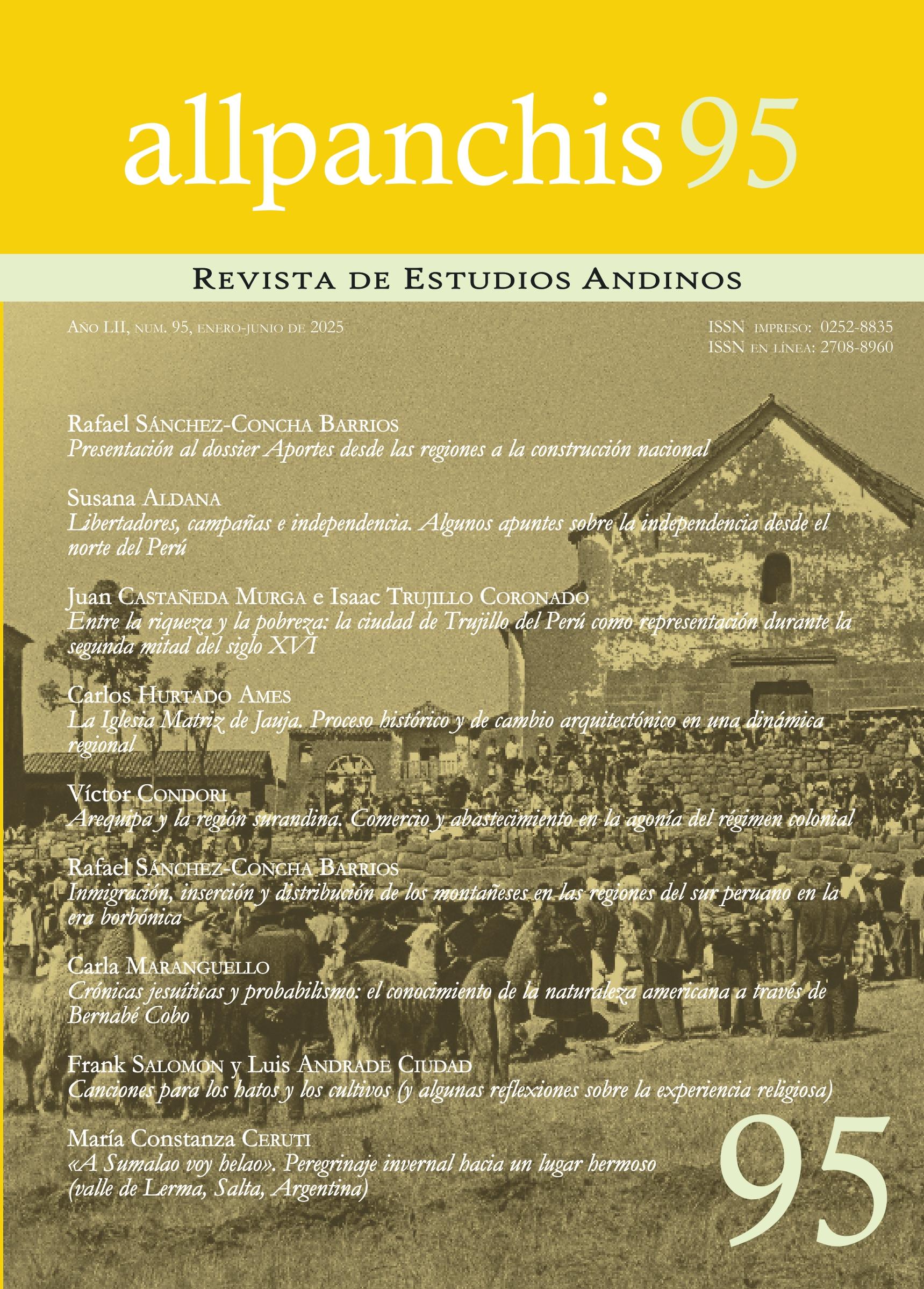Between Wealth and Poverty
DOI:
https://doi.org/10.36901/allpanchis.v52i95.1494Keywords:
Trujillo, representation, encomenderos, citiesAbstract
This research analyzes how the city of Trujillo was represented by local authorities, neighbors and chroniclers during the second half of the 16th century, in a context where the monarchy was beginning to establish itself bureaucratically in the Peruvian viceroyalty and to show the first results of the application of the new laws. The city of Trujillo began to be seen as a fertile place during the first years of the conquest, but, only a few years later, due to a period of economic and demographic crisis caused by the creation of the village of Saña, which attracted the interest of the encomenderos who did not hesitate to abandon it and settle in it, transformed the representation of this city. Although the crisis was overcome a decade later, the encomenderos were economically harmed, unlike those who were dedicated to commerce. It is argued that the representation of the city of Trujillo as an impoverished city was generated by those who, in order to obtain economic support from the viceregal authorities, did not hesitate to spread it openly.
Downloads
References
AINSA, F. (1992). De la edad de oro a el Dorado. Génesis del discurso utópico americano. México: Fondo de Cultura Económica.
CASTAÑEDA, J. (1996). Notas para una historia de Trujillo del Perú en el siglo XVII. En: L. Millones y H. Tomoeda (eds.). La tradición andina en tiempos modernos. Oasaka: National Museum of Ethnology, pp. 23-45.
GARCÍA, C. (1986). Haciendas municipales y bienes de propios. Anales de estudios económicos y empresariales, núm. 1, pp. 89-114.
GONZÁLEZ, C. (1995). Dineros de ventura: la varia fortuna de la emigración a Indias (siglos XVI-XVII). Sevilla: Universidad de Sevilla.
LISSON, E. (1944). La iglesia de España en el Perú, vol. II. Sevilla: Editorial Católica Española.
LIZÁRRAGA, R. de (1987). Descripción del Perú, Tucumán, Río de la Plata y Chile. Madrid: Historia 16.
LÓPEZ, J. (1894). Geografía y descripción universal de las Indias. Madrid: Real Academia de la Historia.
MURÚA, M. de (2001). Historia general del Perú. Madrid: Dastin.
OTTE, E. (1996). Cartas privadas de emigrantes a indias. México: Fondo de Cultura Económica.
PEASSE, F. (1995). Las crónicas y los Andes. México: Fondo de Cultura Económica.
PUENTE, J. de la (1992). Encomienda y encomenderos en el Perú. Estudio social y político de una institución colonial. Sevilla: Diputación Provincial de Sevilla.
RAMÍREZ, S. (1992). Los señores patriarcales: la tenencia de la tierra en el Perú colonial. Lima: Instituto de Estudios Peruanos.
RIVASPLATA, P. (2015). El clima «miasmática» limeño según algunas percepciones de autoridades médicos y viajeros durante los siglos XVI al XIX. Temas Americanistas, núm. 34, pp. 76-98.
ZÁRATE, A. de (1994). Historia del descubrimiento y conquista del Perú. Lima: Pontificia Universidad Católica del Perú.
ZEVALLOS, J. (1990). Pretendientes a la encomienda de Chicama en 1583. Boletín del Instituto Riva Agüero, núm. 17, pp. 373-381.
ZEVALLOS, J. (1996). Los fundadores y primeros pobladores de Trujillo del Perú. Trujillo: Ediciones de la Fundación Pinillos Goicochea.
Downloads
Published
Issue
Section
License
Copyright (c) 2025 Juan Castañeda Murga, Isaac Trujillo Coronado

This work is licensed under a Creative Commons Attribution 4.0 International License.
Los trabajos publicados están sujetos a la licencia de Creative Commons versión 4.0 bajo las siguientes condiciones: CC-by: Se permite la posibilidad de copiar, distribuir, exhibir, y producir obras derivadas, siempre y cuando se reconozca y cite al autor y la fuente correctamente.
Los lectores pueden acceder gratuitamente a los contenidos de la revista siempre que no vulneren las restricciones anteriormente explicadas.
Los autores mantienen sus derechos de autor (copyright) al publicar en Allpanchis. Ceden, a su vez, por un periodo de 10 años los derechos de publicación (publishing rights) de la versión aceptada (accepted version) y publicada (published version) para la publicación impresa en el número acordado y de manera virtual sin límite de tiempo. En caso los autores u otroa editores deseen republicar el artículo, se debe solicitar el permiso necesario de Allpanchis. Sucedida esa situación, se agradece remitir la información de la republicación (un ejemplar impreso o, si es solamente virtual, el respectivo enlace).
Los autores pueden guardar el archivo de las versiones enviadas (submitted version), aceptada (accepted version) y publicada (published version) en modalidad de autorarchivo, en repositorios institucionales, temáticos o sitios web personales).





